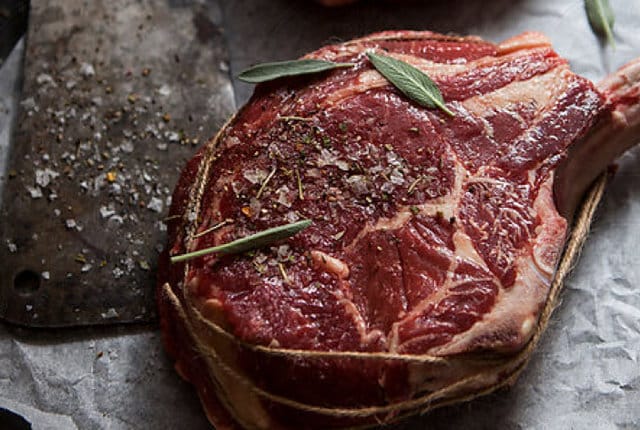The Benefit of Grass-Fed Meats for Dogs
By Dr. Mark Roberts, PhD
In New Zealand grass fed cattle are a common sight, indeed grain feed animals and feedlots are a rarity. Not only is this better for the welfare of the animals, but also impacts on the nutrients within the meat. Indeed, research spanning three decades suggests that grass-based diets can significantly improve the fatty acid (FA) composition and antioxidant content of beef1. The significance of nutrition on fatty acid composition is clearly demonstrated when profiles are examined by omega 6 (n-6) and omega 3 (n-3) families. Although, there is no significant change to the overall concentration of n-6 fatty acids between feeding regimens, grass-fed beef consistently shows a higher concentrations of n-3 FAs as compared to grain-fed contemporaries, creating a more favorable n-6:n-3 ratio2.
Analysis of grass fed verse grain fed cattle, highlights that this ratio can be as much as four times more omega 3 fatty acids to omega 6 in favour of those animals which are grass fed. Omega 3 fatty acids consists of several important members for a dog. Conjugated linoleic acid (CLA) is one such fatty acid which shows significantly higher levels in grass fed cattle, compared to grain fed. The inclusion of CLA in the diets of dogs has been shown to help in several beneficial areas for dogs, including body fat reduction3 and prevention and treatment of inflammatory diseases4.
In addition to CLA, Eicosapentaenoic acid (EPA) and Docosahexaenoic acid (DHA) have been demonstrated to also be significantly higher in cows that eat grass, compared to grain5,6. In dogs, the anti-inflammatory effects of EPA and DHA was elegantly demonstrated in a study, whereby significant reductions in serum proinflammatory protein activities occurred in dogs fed a diet supplemented with both of these omega 3 fatty acids7. A major area of inflammation in dogs involves the joints, which can lead to deterioration of the joint cartilage, accompanied by chronic pain, lameness and stiffness. A relevant study specifically examined the impact a high omega 3 diet had on dogs which had undergone surgery to repair a damaged cruciate ligament. The findings of the research showed that dogs fed a diet with a high inclusion of omega 3 fatty acids had better ground reaction forces and fewer changes of osteoarthritis (a form of chronic joint inflammation) compared with consumption of a high n-6 diet8. Moreover, the use of omega 3’s (EPA and DHA), has also been demonstrated to decrease progression of osteoarthritis in dogs not having had a surgical intervention9. These findings clearly support the use of EPA and DHA enriched diets as part of anti-inflammatory treatments for dogs with chronic inflammatory diseases.
Additionally, both EPA and DHA regulate a wide range of functions, including blood pressure, blood clotting, and correct development and functioning of the brain and nervous system10. This was displayed in a study, examining the impact of omega-3 polyunsaturated fatty acid supplementation on the cognitive function of growing dogs. The results concluded that the cognitive function was significantly improved, in comparison to dogs with no supplementation11. Another example, involving puppies, focused on DHA which is a key building block for neural tissues and is important in brain function. The specific need for DHA in the diets of puppies was demonstrated, when nine week old dogs were taught to associate a square or circle with the treat location. The results underlined that the level of success, was correlated with a higher dosage of supplemented DHA provided to the puppies12.
As discussed, omega 3 fatty acids, in particular CLA, EPA and DHA sourced from grass fed cattle, provide numerous health benefits to a dog. Unfortunately, as dogs cannot sythesise these important fatty acids, providing them in their diet is essential. As Firstlight Dog Food only uses cattle which consume grass, and not grain, it is clearly a better approach in helping a dog live a happy, healthier life.
References
1. Daley, C. A., Abbott, A., Doyle, P. S., Nader, G. A., & Larson, S. (2010). A review of fatty acid profiles and antioxidant content in grass-fed and grain-fed beef. Nutrition journal, 9, 1-12.
2. Hall, N., Schonfeldt, H. C., & Pretorius, B. (2016). Fatty acids in beef from grain-and grass-fed cattle: the unique South African scenario. South African Journal of Clinical Nutrition, 29(2), 55-62.
3. Rivera, N. L. M., Félix, A. P., Ferreira, F. M., Silva, A. V. F. D., & Maiorka, A. (2011). Body measurements and serum lipid profile of overweight adult dogs fed diet with containing conjugated linoleic acid. Ciência Rural, 41, 2020-2025.
4. Wang, L. S., Huang, Y. W., Liu, S., Chang, H. L., Ye, W., Shu, S., … & Lin, Y. C. (2006). Conjugated linoleic acid (CLA) modulates prostaglandin E2 (PGE2) signaling in canine mammary cells. Anticancer research, 26(2A), 889-898.
5. Leheska, J. M., Thompson, L. D., Howe, J. C., Hentges, E., Boyce, J., Brooks, J. C., … & Miller, M. F. (2008). Effects of conventional and grass-feeding systems on the nutrient composition of beef. Journal of animal science, 86(12), 3575-3585.
6. Garcia, L. G., Nicholson, K. L., Hoffman, T. W., Lawrence, T. E., Hale, D. S., Griffin, D. B., … & Smith, G. C. (2008). National Beef Quality Audit–2005: Survey of targeted cattle and carcass characteristics related to quality, quantity, and value of fed steers and heifers. Journal of Animal Science, 86(12), 3533-3543.
7. LeBlanc, C. J., Horohov, D. W., Bauer, J. E., Hosgood, G., & Mauldin, G. E. (2008). Effects of dietary supplementation with fish oil on in vivo production of inflammatory mediators in clinically normal dogs. American journal of veterinary research, 69(4), 486-493.
8. Budsberg SC, Bartges JW, Pazak HE, et al. Effects of different N6:N3 fatty acid diets on canine stifle osteoarthritis. Veterinary Orthopedic Society 28th Annual Meeting; 2001.
9. Verpaalen VD, Baltzer WI, Smith-Ostrin S, et al. Assessment of the effects of diet and physical rehabilitation on radiographic findings and markers of synovial inflammation in dogs following tibial plateau leveling osteotomy. JAVMA 2018;252:701-709
10. Chapkin, R. S., Kim, W., Lupton, J. R., & McMurray, D. N. (2009). Dietary docosahexaenoic and eicosapentaenoic acid: emerging mediators of inflammation. Prostaglandins, Leukotrienes and Essential Fatty Acids, 81(2-3), 187-191.
11. Rodrigues, R. B. A. (2021). Effects of omega-3 polyunsaturated fatty acid supplementation on the cognitive function and metabolomic of growing dogs.
12. Kelley R. Linking puppy trainability and nutrient status. Proceedings NAVC Conference 2008; 22: 1575-1576









